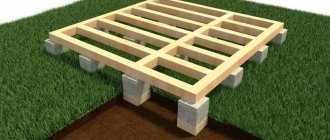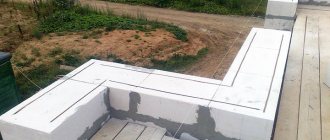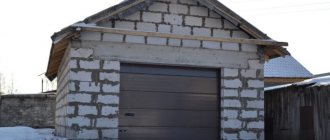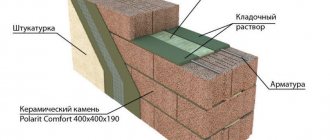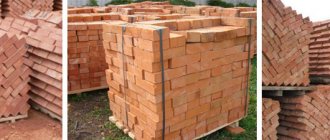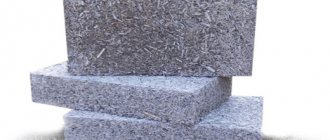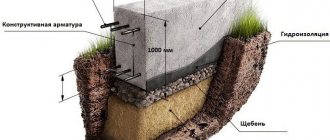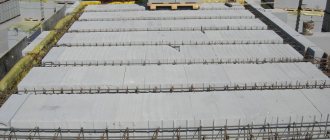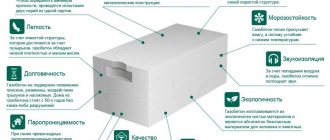The highest quality aerated concrete blocks are produced using automated equipment in the production workshop.
But you can also get this building material at home.
True, it will be produced using a different technology and with worse performance indicators.
This article is for those who are interested in the process of creating one of the most popular materials for wall construction - aerated concrete.
Mixture recipe for gas blocks
There is no single recipe for creating aerated concrete . Its manufacturing technology is similar to cooking a dish - there are basic ingredients, but their quantity and the presence of other components are regulated by each housewife to her taste. It’s the same with aerated concrete.
There are several main ingredients that make up the mixture, but their proportions depend on the brand of material density and the technology that will be used in the workshop.
The presence of additional components in the composition is also at the local level at the discretion of the manufacturer, that is, he either adds special plasticizers to improve the properties of aerated blocks, or stops only at the main components of the product.
The main ingredients that make up aerated concrete:
- Cement (with or without additives). Sulfate-resistant binder must not be added to the mixture. The brand of cement is taken depending on the purpose of the blocks. If these are thermal insulating elements, then the cheapest brand is suitable - M300, and for the manufacture of structural products you will need the M500 brand.
- Sand (without clay and impurities). To ensure the purity of the sand, it is sifted several times. The finer the sand fraction, the better the quality of the finished products.
- Water (plain, drinking).
- Gas formers. It can be aluminum powder or paste.
- Lime (crushed, quicklime).
- Other components, plasticizers, additives - to increase the rate of hardening, ductility, uniformity of structure, strength and service life of products.
Full information about the ingredients for making aerated blocks is here.
Production of cellular concrete: main methods
There are two main options - autoclave and non-autoclave technology for the production of cellular concrete. There are both differences and certain similarities between them. So, in both cases, the main ingredients of the raw materials remain the same. The preparatory stage of production is also not much different: it is the preparation of forms and solution, and then the pouring of the arrays. We can see the main differences only at the final stage. The first method of producing blocks from cellular concrete involves steaming the products in an autoclave, that is, with highly heated steam and high pressure. With a non-autoclave production method, hardening occurs under natural conditions - that is, normal temperature, humidity and other atmospheric characteristics.
Manufacturing equipment
Conveyor-type equipment is used in production workshops. And such a conveyor line looks something like the one shown in the illustration below.
The standard conveyor line for the production of gas blocks includes:
- containers or bunkers for raw materials;
- belt conveyor for moving components;
- unit for mixing the solution;
- autoclaves – ovens for processing material;
- blank molds for future products;
- bulk materials dispenser;
- water dispenser;
- cutting unit - for cutting a large block into small elements of specified sizes;
- steam generator – for supplying steam to the autoclave;
- vibrating sieve - for sifting sand;
In addition to the above equipment, you also need:
- crushers;
- trolleys;
- unit for automating process control;
- forklift of finished products onto pallets.
The total cost of the conveyor line will be over 55 million rubles. To accommodate all this equipment, about 4000 m2 is required. But the equipment productivity will be approximately 300,000 m3 annually.
More information about the equipment can be found in the article at the link.
Technology
There are 2 technologies for the production of gas blocks:
- by autoclaving;
- without using an autoclave.
An autoclave is a special oven that is needed for additional processing of material. Thanks to this firing with steam and high temperature, the finished product becomes more durable.
Non-autoclaved items do not undergo this treatment. They harden naturally by simply moistening and drying the blocks. Typically, such elements are produced as a budget option for building materials. It is not recommended to build load-bearing walls with them, since there is no guarantee that they will withstand a serious load from the total weight of the structure.
In order to somehow improve the properties of non-autoclaved products, various modified additives are added to their composition.
Products that enter the autoclave are treated at temperatures from 190°C to 200°C and steam pressure from 10 to 12 bar. The price of autoclave products is approximately 10% higher than non-autoclave products , since their production requires more energy.
How does autoclaving work? The blocks, which have already been cut by a cutting unit into the required sizes, are transported via a conveyor to the autoclave. They remain there for 12 hours, after which the products are ready for use, since they have reached their declared brand strength.
Non-autoclave elements are ready for use only a month after manufacture.
| Characteristic | Analysis of products made by autoclaving and without autoclaving |
| Relationship between density and thermal conductivity | Autoclaved products have much better performance than non-autoclaved materials. |
| Frost resistance | According to GOST, the frost resistance requirements for autoclaved products are much higher than for non-autoclaved ones. |
| Life time | About the same. |
| Geometric shapes and appearance of products | The autoclave has ideal geometric shapes, thanks to which the products are obtained in ideal sizes. Deviations can be up to 1 mm. Self-made blocks are not geometrically accurate. |
| Fragility of the material | For non-autoclaved products it is much higher than for autoclaved ones. |
| Shrinkage after drying | For non-autoclave elements it is greater. |
| Complexity of production | The technological process is the same, but to create autoclave materials you need an autoclave, and this is extra material costs. |
Production stages
The creation of building material itself occurs in the following sequence:
- First you need to prepare all the components;
- Next, the filling mixture is made;
- Blocks are formed and solidified;
- Cutting material into products of the required size;
- Processing blocks in an autoclave;
- Packaging of finished aerated concrete.
Each stage should be considered in more detail.
Preparation of materials
To prepare 1 cu. m of mixture, you need to prepare the components in the following proportions:
- Water in a volume of 450 l.;
- Lime - 120 kg, but not more than 20% of the total volume;
- Cement – 60 kg, the content of which in the solution is approximately 10%;
- Quartz sand – 450 kg, with a quartz content of more than 80%;
- Gypsum – 500 g, 2nd class;
- Aluminum powder – 500 g.
To achieve the best density of gas silicate blocks, the proportion of pores in them should be no more than 38%. This will allow the products to be used for the construction of permanent structures. Medium-density products have up to 52% voids, and the lightest options contain up to 92% pores. They are used only as a thermal insulation material.
Making the mixture
When the components are prepared, you need to sift the quartz sand and then grind it in a ball mill. After this, water is added to it. All this is fed into an aerated concrete mixer. The remaining components are sequentially added there, bringing their content to the required consistency. Next, aluminum powder is introduced into the solution, after which the composition is mixed.
Monitoring compliance with proportions should not be carried out independently; this must be entrusted to the electronic control system for greater accuracy.
Molding
The resulting mixture is poured into pre-prepared molds, where it is kept at an air temperature of 40 °C for about 4 hours. During this time, the mass rises, similar to yeast dough, which is due to the release of gas. The process continues until the maximum swelling mass is reached, when the formation of hydrogen ends. Then the products are aged for another hour to gain plasticity.
A distinctive parameter of gas silicate is its color. It only comes in white with a uniform structure. Therefore, if, under the guise of such products, they offer to purchase blocks of a darker color, most likely, they are offering classic foam blocks.
Solid cutting
To obtain gas silicate blocks, it is necessary to process all surfaces of the material. First, the side parts are removed using special knives. If necessary, a tongue-and-groove system is formed. Next, vertical as well as horizontal cutting is performed using tensioned strings. All waste resulting from this process is used to re-prepare the mixture, making the process waste-free.
Autoclave processing
The autoclave itself is a steam chamber where blocks are processed at high humidity and under high pressure. Through the use of such equipment for the production of gas silicate, the strength properties of the material are improved, becoming denser, lighter and smoother. A pressure of more than 12 atmospheres is created in the chamber for 12 hours, and a temperature of 180 °C is pumped up. After this, the pressure is reduced and the finished products are removed from the autoclave.
Package
The finished products are laid out on the prepared surface until they cool completely. Further packaging is carried out using an automatic line that prevents the formation of dirt or chips on the surface of the gas silicate blocks. They are supplied for sale already sealed and ready for use.
Most manufacturers of gas silicate blocks in Russia prefer automated lines. This is due to the high quality, speed and lower costs of creating such building material. Automation copes better with routine processes and clearly follows the proportions of components and the sequence of actions.
Requirements for workshops for creating aerated concrete blocks
Silos are used to store cement and lime, and aluminum powder should be stored in 200 liter metal barrels. Finished products are stored in closed, well-ventilated areas so that moisture and dampness do not destroy the products.
The production workshop is designed according to the following standards:
- GOST 12.1.005-76;
- SNiP III-4-80.
They state the rules :
- microclimate;
- ventilation;
- heating;
- air conditioning;
- sanitary;
- fire department;
- explosive;
- environmental safety.
Unauthorized persons should not be in the production area , and all workers are required to wear helmets to avoid head injuries. Only persons who have passed the occupational safety and production knowledge exam are allowed to work.
If a process is carried out indoors using water, then the flooring should be non-slippery or wooden flooring should be laid on it. The coating must be such that spilled or spilled substances, as well as industrial waste and dirt can be easily cleaned from it.
All operations related to loading and transportation of materials must be automated. Control panels must be located in separately isolated cabins. Elements of equipment that move and rotate must be guarded.
How to do it yourself?
To make aerated concrete at home you need:
Prepare blank forms that you can buy or make yourself.
To do this, take even, smooth boards, which are knocked together in the form of a pencil case. Jumpers are installed inside according to the dimensions of future products. Jumpers can be made from waterproof multi-layer plywood.- Lubricate the surface of the mold with used machine oil diluted in water in a ratio of 1:3 (1 – oil, 3 – water). This procedure is performed before each new mold filling.
- Preparing the mixture. To obtain a high-quality solution, the ingredients are added gradually, in small portions. Stirring should be every 5 minutes.
For example, you can take 100 kg of cement, 180 kg of sand, 60 liters of water, and then add 0.5 kg of sodium sulfate, 1.5 kg of caustic soda to the mixed mixture. At the very last moment, 0.4 kg of aluminum powder is poured into the mixture (a little at a time).Then the entire solution is thoroughly mixed for about 1 minute. The reaction after adding the blowing agent begins approximately 5-10 minutes after the last stirring and lasts for 15-30 minutes. The pore formation process should not be too intense or slow, otherwise the products will not have a uniform pore structure .
- Filling with forms .
The solution is poured into the workpieces only up to half, since as a result of the reaction the mass will begin to increase in volume by about half and then shrink back. If you fill the mold to the brim, the solution will spill out. In order for all the blocks to be the same height and not shrink, the blank form must be heated along the entire length at the same temperature. During the hardening process, it is important to avoid drafts. - After the pore formation process is completed, the upper part with the bumps is carefully cut off with a string. Then the blocks remain in the molds for another 24 hours until they harden, after which they are removed and carefully transferred to another site until the products completely harden (within a month).
Information about all the intricacies of independent production can be found here.
Features of manufacturing technology
Gas silicate blocks are made from a silicate mixture with the addition of aluminum powder. As a result of the reaction between these materials, silicate foam is formed. It can be autoclaved, making it more durable. The final product is finished blocks.
For the production of gas silicate blocks, only natural, environmentally friendly materials are used: cement, sand, lime, gypsum and water. They are mixed in a given proportion with the addition of aluminum powder, which acts as a gas former.
During the reaction between aluminum powder and lime, the mixture foams and acquires a special structure. Using special equipment, you can adjust the pore size and obtain a material with different properties.
The block production technology is simple and does not require significant investment. The production process is fully automated. With the help of high-tech lines, all its nuances are regulated - from the ratios of raw materials to the thermal conductivity coefficient. That is why gas silicate blocks are invariably of high quality, and the material characteristics are the same for all products.
Product certification
According to the legislation of the Russian Federation, mandatory certification of compliance with GOST is not required for gas blocks . But in order to confirm the quality of their products, many manufacturers provide voluntary certification, which costs about 6,000 rubles. for 1 year or 7000 rub. – for a period of 3 years.
To obtain a voluntary certificate you need:
- identification number of the owner of the company - original and copy certified by seal and signature;
- a document confirming the registration of the organization, or a record sheet - originals and copies;
- technical specifications (if any);
- company details;
- lease agreements for production workshops – originals and copies;
- application for voluntary certification.
In addition to the product quality certificate, you can obtain voluntary fire safety certification, as well as an Expert Opinion confirming that the product meets sanitary, environmental and hygienic standards.
You can also issue a refusal letter. This is an official document from a certification organization, which states that this product does not require certification or declaration. The price for such a service is from 4000 rubles.

